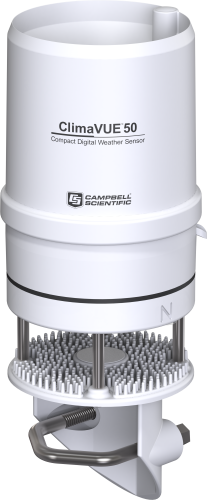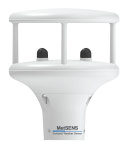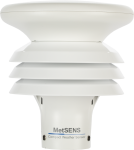This product is not available for new orders. We recommend ordering: ClimaVue 50 G2.

| Services Available |
|---|
Resumen
El ClimaVue™50 es un sensor meteorológico todo-en-uno asequible que satisface sus necesidades comunes de monitorización meteorológica con sencillez, cuando se combina con cualquiera de las plataformas de recogida de datos altamente flexibles y escalables de Campbell Scientific. Este sensor utiliza el protocolo SDI-12 para transmitir la temperatura y humedad relativa del aire, presión de vapor, presión barométrica, viento (velocidad, ráfaga y dirección), radiación solar, precipitación y caída de rayos (recuento y distancia). Todo ello sin piezas móviles y con un bajo consumo de energía. Un sensor de inclinación integrado garantiza la integridad de los datos a largo plazo. Este producto es ideal para un montaje rápido, ubicaciones remotas, grandes redes, como parte de un sistema más complejo, o si sólo necesita algo sencillo.
Leer másVentajas y características
- Todas las típicas medidas meteorológicas accesibles mediante una simple salida digital (SDI-12)
- Consumo medio inferior a 1mA, ideal para sitios donde sólo sea viable alimentación solar
- Inclinómetro integrado que ayuda a tener siempre nivelado el sensor
- Bajo mantenimiento, sin partes móviles, lo que reduce costes y tiempo
- No requiere configuración
- Diseño compacto con una rápida puesta en marcha y bajo impacto visual
- Compatible con los dataloggers Campbell Scientific
- Cable desmontable, que facilita la sustitución en campo
Imágenes













Descripción detallada
Sensores
Todos los sensores están integrados en una única unidad de tamaño reducido que se instala fácilmente. Con un diseño robusto y sin piezas móviles que evita errores debidos al desgaste o la suciedad, el ClimaVue 50 es ideal para instalaciones remotas de uso prolongado.
Piranómetro
La radiación solar se mide mediante un piranómetro integrado en el borde del embudo del pluviométro situado en la parte superior de ClimaVue 50. El piranómetro en miniatura utiliza un sensor basado en célula de silicio para medir la radiación solar global incidente (directa y difusa). Los sensores basados en célula de silicio tienen un excelente tiempo de respuesta a los cambios en las condiciones de radiación y una sensibilidad aceptable en todo el espectro solar, lo que los hace muy adecuados para su uso en el ClimaVue 50.
El cabezal con corrección del coseno cuidadosamente desarrollado, garantiza lecturas precisas independientemente del ángulo del sol, mientras que el material del filtro óptico, meticulosamente investigado, equilibra el coste y el rendimiento para garantizar que la célula de silicio proporcione a ClimaVue 50 una buena precisión independientemente de la temperatura o la antigüedad del sensor.
Anemómetro y veleta
El espacio debajo del pluviómetro es donde ClimaVue 50 mide la velocidad y dirección del viento. Las señales ultrasónicas emitidas por transductores situados en ángulo recto rebotan en la placa porosa de vidrio sinterizado y vuelven al sensor opuesto. La velocidad del sonido se ve afectada por el viento, y la velocidad del viento se calcula midiendo las diferencias en el tiempo que tarda el sonido en viajar desde los transmisores hasta los receptores.
Sensor temperatura
La medida de la temperatura del aire con el ClimaVue 50 se realiza en el centro de la zona del anemómetro, donde una pequeña aguja de acero inoxidable que contiene un diminuto sensor de temperatura (termistor) se extiende desde el centro de los cuatro transductores sónicos en el centro del anemómetro.
A diferencia de la mayoría de las medidas de temperatura del aire, el sensor de temperatura no está cubierto con placas de rejilla para protegerlo del calentamiento solar. En su lugar, se sitúa al aire libre, susceptible al calentamiento solar del cuerpo del instrumento. Sin embargo, ClimaVue 50 corrige con precisión la temperatura del aire medida porque se conocen la radiación solar y la velocidad del viento. Estas dos son las principales variables que determinan el error entre la temperatura del aire medida y la temperatura real del aire. A continuación, se utiliza una ecuación de balance energético para calcular cuál debería ser la temperatura real con una precisión de ±0,6 °C.
Para más información, ver "ClimaVUE™50—Correction of air temperature measurements from a radiation-exposed sensor" technical paper.
Sensor humedad relativa
El sensor de humedad relativa del ClimaVue 50 está situado detrás de la pantalla circular de Teflon™, cerca de los transductores sónicos. La pantalla de teflón protege el sensor del agua líquida y el polvo, al tiempo que permite que el vapor de agua pase libremente al sensor. El ClimaVue 50 mide la humedad relativa y la temperatura y calcula la presión de vapor.
Pluviómetro
El ClimaVue 50 contiene un embudo de recogida de lluvia de 9,31 cm de diámetro. Un muelle en el embudo actúa como filtro para mantener alejadas las partículas grandes, al tiempo que permite un caudal suficiente para que el agua no se acumule. La lluvia recogida por el embudo sale de éste a través de un orificio abocinado de precisión que forma la lluvia en gotas de un tamaño conocido. Las gotas que caen golpean y puentean momentáneamente el espacio entre dos contactos dorados, creando un impulso eléctrico.
El ClimaVue 50 cuenta los impulsos (gotas) y calcula el volumen de agua. A medida que aumenta la intensidad de la lluvia, las gotas se hacen más pequeñas, pero el firmware de ClimaVue 50 contiene un algoritmo para compensar automáticamente el tamaño de las gotas a medida que aumenta la lluvia.
Nota: Este sensor no calefactado no es adecuado para mediciones de precipitaciones sólidas ni ambientes con escarcha.
Inclinómetro
El ClimaVue 50 también incluye un inclinómetro. El uso principal del inclinómetro es garantizar que ClimaVue 50 permanezca nivelado en todo momento. Compruebe regularmente los datos de inclinación X e Y para asegurarse de que ClimaVue 50 está nivelado; si se ha inclinado, vuelva al lugar y nivélelo de nuevo. Tres grados de desnivel pueden causar errores en las mediciones de lluvia y radiación solar. Aunque las lecturas de este sensor pueden utilizarse para nivelar el instrumento durante la instalación, es mucho más fácil utilizar el pequeño nivel de burbuja situado en la parte inferior de la placa del anemómetro.
Montaje
ClimaVue 50 incluye un perno en V para su fijación a un poste con un diámetro exterior nominal de 31,8 a 50,8 mm (1,25 a 2,0 pulg.). Esto permite montar el sensor directamente en un mástil de un trípode o en un poste de montaje de la serie CM300, o en una brazo horizontal utilizando el kit de tubo de montaje 17387 mounting pipe kit.
Productos similares
Preguntas frecuentes
Número de FAQs relacionadas con ClimaVue 50: 8
Expandir todoDesplegar todo
-
Internally to the ClimaVue 50, precipitation is continually measured. Solar radiation, wind, and air temperature are measured every 10 seconds; orientation, vapor pressure, atmospheric pressure, and relative humidity are measured every 60 seconds. Querying the sensor more often than two times the measurement interval will return raw values. Querying more often than the measurement interval will result in duplicate values and may cause timing problems in the data logger.
-
The average current drain for the ClimaVue 50 during the quiescent state and routine 10 s wind measurement is on the order of 300 µA. Polling with the aR7! command every 60 seconds increases the average current drain to 0.4 mA. Polling with the aR7! command every 10 seconds increases the average current drain to 1 mA.
-
We do not have a heated version of the ClimaVue 50 at this time. The model to correct the air temperature is based on the energy balance and should be good in all situations in which the radiation and wind sensors can collect reliable data; however, unintentional burial in snow and ice may impede the function of both. The ClimaVue 50 will not be a universally great fit for all climates. If the winter precipitation is critical for your study, other instruments will be necessary.
-
The ClimaVue 50 collects all the information necessary to correct for absorbed radiation using an energy balance approach.
-
The ClimaVue 50 does need to be powered continuously to make the routine wind measurements (every 10 seconds) that are combined to give the wind speed and direction. If you only power up and quickly grab a measurement, those wind speed and direction measurements will be of little value, given the inherently variable nature of wind. Campbell Scientific highly recommends that you power the ClimaVue 50 instruments continuously for reliable wind measurement. The average current drain for the ClimaVue 50 during the quiescent state and routine 10 s wind measurement is on the order of 300 microAmps, so battery drain from continuous power should be minimal.
-
The ClimaVue 50 mounting type can be a meteorological stand, pole in cement, or tripod: 31.8 to 50.8 mm, 1.25 to 2.0 in. diameter. The ClimaVue 50 is fitted with a V-bolt, allowing it to be mounted on top of most posts, poles, tripods, etc. Use a wrench to tighten the bolts, securing the ClimaVue 50 flat and tight against the top of the stand.
-
See the maintenance section of the manual for recommendations.
-
The ClimaVue 50 is a microclimate sensor, so you should position it to be representative of the climate relevant to the research questions you are asking. FAO56 gives specific guidelines to the positioning and field size of sensors. If you intend to use the sensor for reference ET, follow those guidelines. Refer to the following: http://www.fao.org/docrep/X0490E/X0490E00.htm.
Especificaciones
| Measurements Made | Air temperature, barometric pressure, lightning average distance, lightning strike count, precipitation, relative humidity, solar radiation, tilt, wind direction, and wind speed. |
| Output | SDI-12 |
| Operating Temperature Range | -50° to +60°C (Except the barometer and RH: -40° to +60°C.) |
| Minimum Supply Voltage | 3.6 Vdc continuous |
| Maximum Supply Voltage | 15.0 Vdc continuous |
| Minimum Digital Input Voltage |
|
| Typical Digital Input Voltage |
|
| Maximum Digital Input Voltage |
|
| Typical Current Drain @ 12 Vdc | < 1 mA (average) |
| Typical Measurement Duration | 110 ms |
| Maximum Measurement Duration | 3,000 ms |
| Maximum Polling Frequency | 10 s |
| Application of Council Directive(s) |
|
| Standards to Which Conformity Is Declared |
|
| Connection Description | 25 mm (10 in.) pigtail with M12 pin (male) 5-pin 316 stainless-steel knurl |
| Diameter | 10 cm (4 in.) including rain gage funnel |
| Height | 34 cm (13.4 in.) including rain gage funnel |
| Weight | 839.15 g (1.85 lb) |
Power Consumption |
|
| Quiescent | 0.3 mA |
| Maximum Peak Current | 33 mA |
| Average Using the R7! Command every 10 s | 1.0 mA |
| Average Using the R7! Command every 60 s (or slower) | 0.4 mA |
Air Temperature |
|
| Measurement Range | -50° to +60°C |
| Resolution | 0.1°C |
| Accuracy | ±0.6°C |
Relative Humidity |
|
| Measurement Range | 0 to 100% |
| Resolution | 0.1% |
| Accuracy | ±3% RH typical (varies with temperature and humidity) |
Barometric Pressure |
|
| Barometer Operating Temperature Range | -40° to +60°C |
| Measurement Range | 500 to 1100 hPa |
| Resolution | 0.1 hPa |
| Accuracy |
|
Vapor Pressure |
|
| Measurement Range | 0 to 47 kPa |
| Resolution | 0.01 kPa |
| Accuracy or Repeatability | Varies with temperature and humidity; ±0.2 kPa typical below 40°C. |
Wind Speed |
|
| Wind Speed Maximum | 10 s gust |
| Measurement Range | 0 to 30 m/s (0 to 67 mph) |
| Resolution | 0.01 m/s (0.02 mph) |
| Accuracy or Repeatability | 0.3 m/s or 3% (0.67 mph or 3%), whichever is greater |
Wind Direction |
|
| Measurement Range | 0° to 359° |
| Resolution | 1° |
| Accuracy | ±5° |
Solar Radiation |
|
| Measurement Range | 0 to 1750 W m-2 |
| Resolution | 1 W m-2 |
| Accuracy | ±5% of measurement (typical) |
| Spectral Range | 300 to 1150 nm |
Precipitation |
|
| Measurement Range | 0 to 400 mm/h (15.75 in./h) |
| Resolution | 0.017 mm |
| Accuracy | ±5% of measurement (from 0 to 50 mm/h or 0 to 1.97 in./h) |
Tilt |
|
| Measurement Range | -90° to +90° |
| Resolution | 0.1° |
| Accuracy | ±1° |
Lightning Strike Count |
|
| Measurement Range | 0 to 65,535 strikes |
| Resolution | 1 strike |
| Accuracy | > 25% detection at < 10 km typical (variable with distance) |
Lightning Average Distance |
|
| Measurement Range | 0 to 40 km (0 to 24.9 mi) |
| Resolution | 3 km (1.86 mi) |
| Accuracy | Variable |
Documentos
Folletos producto
Documentos técnicos
Videos & Tutoriales
Descargas
ClimaVue 50 Example Program v.1 (3 KB) 08-07-2021
An example CR1000X program that uses the R7! SDI-12 command to retrieve data. The program adjusts the barometric pressure measurement to sea level. The adjustment is entered as a constant in the beginning of the program. It assumes the site elevation is 1382 m, and a different value is required for different site elevations.
This program also includes instructions that set wind measurements that are less than 0 to the last valid measurement. These instructions are needed because high winds with rain can temporarily interfere with sonic wind measurements.
Casos de aplicación
Overview In 2020, due to the COVID-19 pandemic, the Formula 1 World Championship calendar was subject......leer más
Solar energy is the most abundant clean energy source available on earth, but the intermittent......leer más
Summary Problem The University of Birmingham had set up and was operating 26 weather stations across the......leer más
















